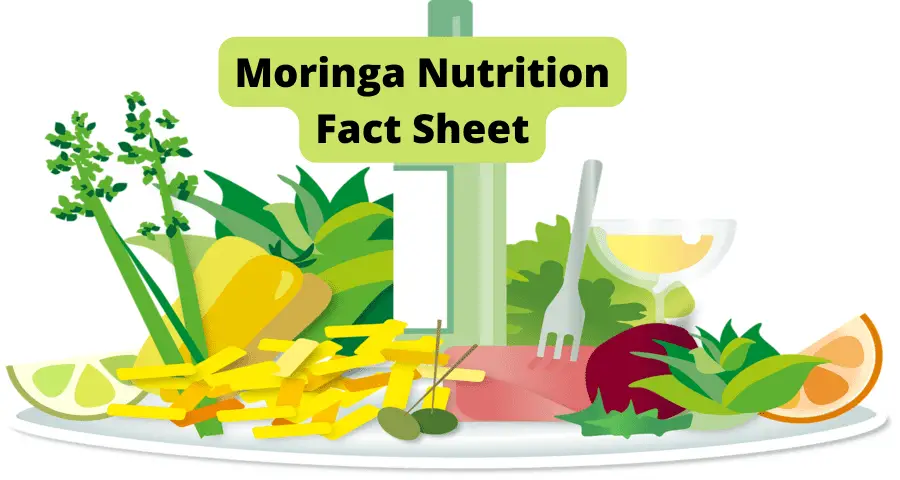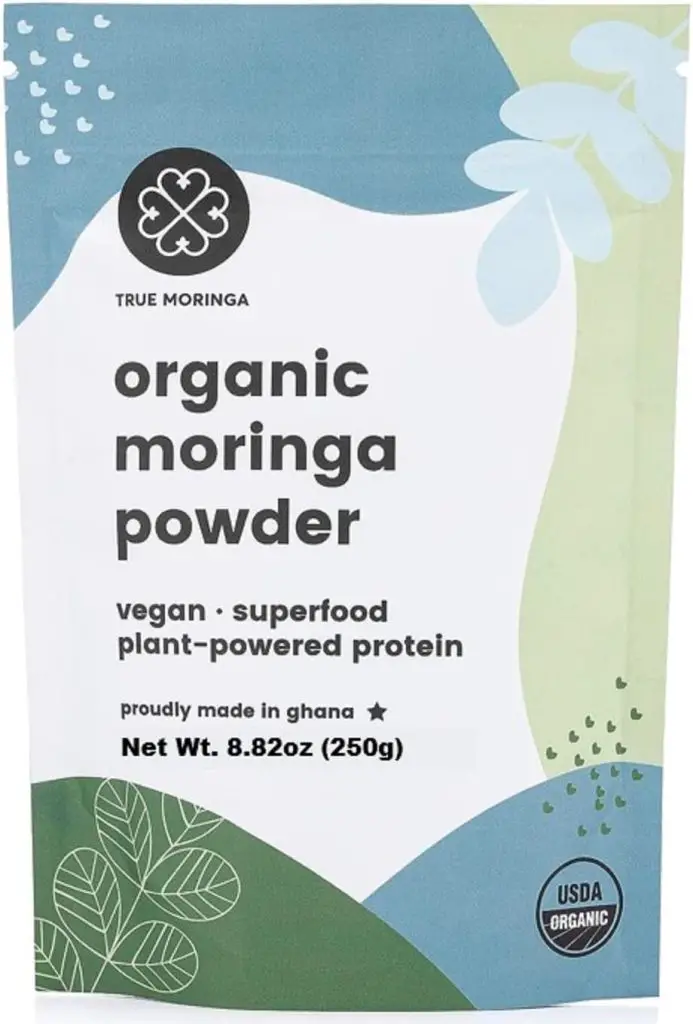Dive into the Green Goodness: Moringa’s Nutritional Factsheet Unpacked!
Nutrition has always been a bit of a challenge for us as a society. Blame it on the easy availability of cheap, not-so-healthy foods, economic disparities, lack of education, or just personal preferences.
It’s a complex issue, and according to a 2015 report by the Office of Disease Prevention and Health Promotion, a whopping 87% of Americans eat fewer veggies than they should, and 75% fall short on the fruit front. That’s not a great recipe for avoiding heart disease or high blood pressure.
To learn more about the nutritional benefits of 1 teaspoon of Moringa powder, check out the article below:
Moringa Nutrition Facts
A 10-gram serving of Moringa leaf powder (the industry standard of daily consumption) has:
- Calories: 28.70.
- Protein: 2.74 grams.
- Fat: 0.29 grams.
- Carbohydrates: 3.81 grams.
- Fiber: 2.44 grams.
- Vitamin B1: 0.17 milligrams.
- Vitamin C: 2.02 milligrams.
- Vitamin E: 9.70 milligrams.
- Calcium: 182.77 milligrams.
- Magnesium: 29.60 milligrams.
- Potassium: 145.80 milligrams.
- Iron: 3.11 milligrams.
Take a look at the chart below where this information is further broken down for the daily values.
Moringa Nutrition Value In A Chart
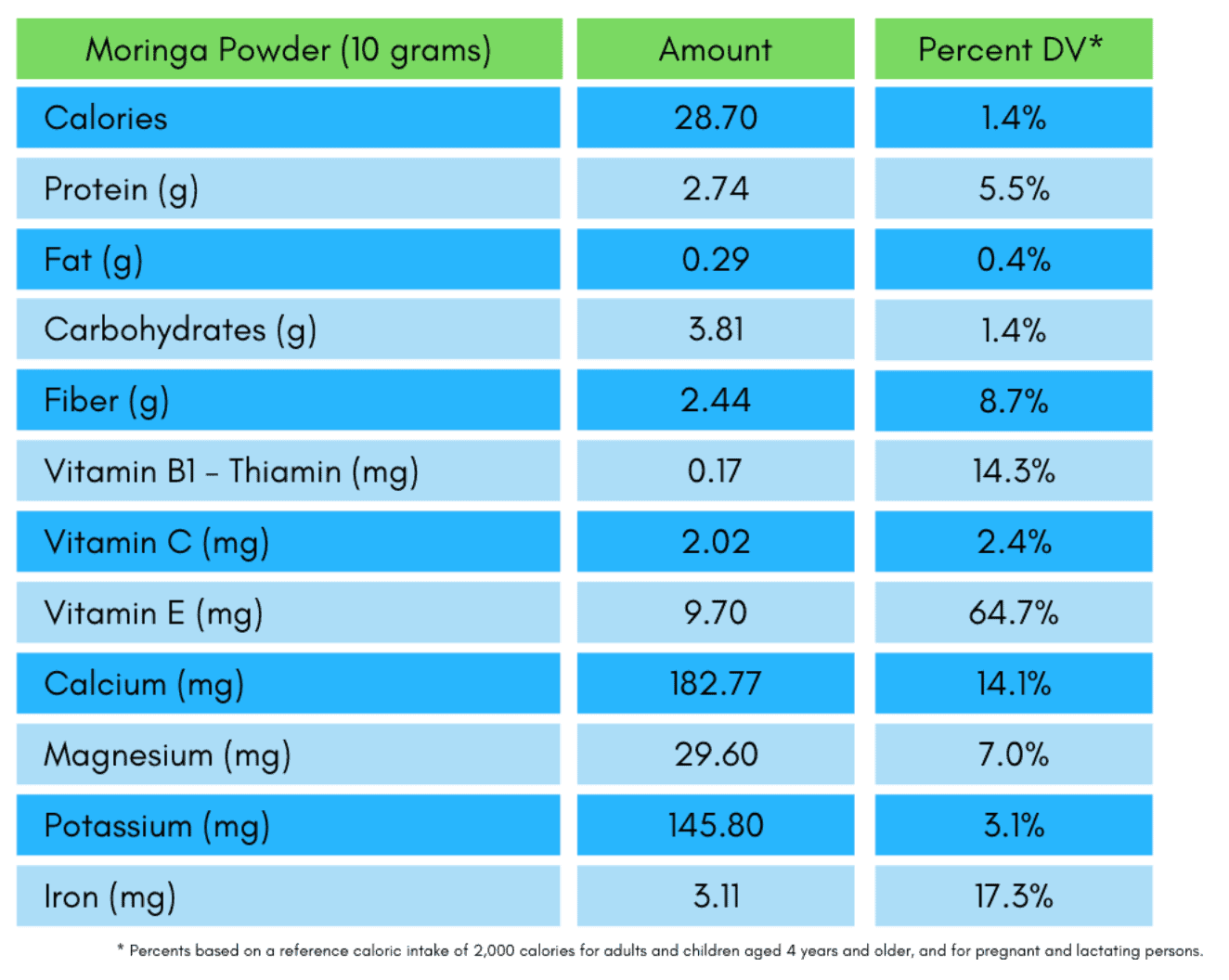
If food is nutrient-rich enough, after all, won’t it offset some of the more unhealthy food choices we make?
Unfortunately, nutrition isn’t that simple: there is no such thing as a single food that’s going to simultaneously solve your every health problem while also giving you free rein to eat all the fried ice cream you want.
If there were, I would have discovered it by now, and would constantly be eating fried ice cream!
Still, slow changes to your diet can help, and Moringa leaf powder is full of vitamins, minerals, and antioxidants (including heavyweights like Calcium, Iron, and Vitamin E) that even small amounts can potentially help.
Remember to stay away from the Moringa pods and Moringa root unless you’ve done your research on them, and when people reference the Moringa tree, they are mostly talking about the Moringa leaves.
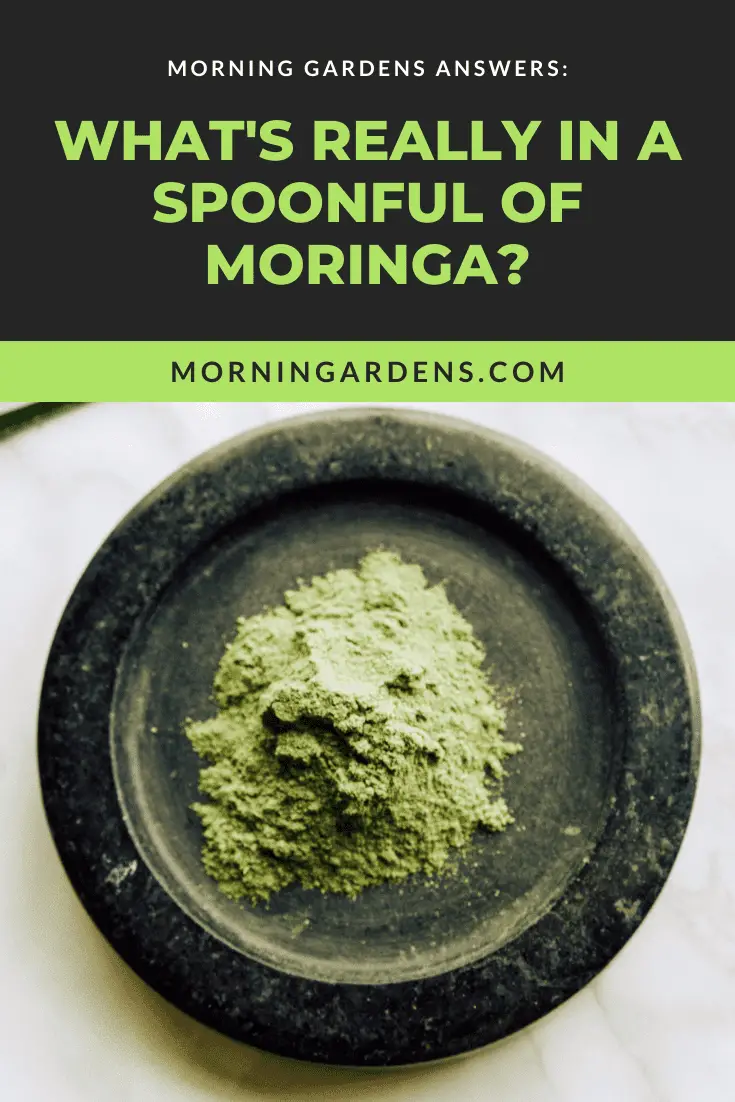
Moringa Nutrition Profile: An Overview
The nutrition information you saw above is an average from three different sources, including research studies and the USDA.
The Moringa Oleifera nutrient profile is dependent upon soil, weather conditions, cutting frequency, spacing, and (perhaps most importantly) drying method. So Moringa trees grown in Nigeria are going to have slightly different nutrient profiles than those grown in India, and those grown in India are going to have slightly different profiles than those grown in your backyard.
Taking an average gives us the best possible indication of what you can expect of any Moringa powder you buy, or of any Moringa leaves you powder at home.
The above chart gives you nutrition information on 10 grams of Moringa leaf powder. 10 grams is the rough equivalent of 0.35 ounces or about 1.5 tablespoons. In other words, with one scoop of powder, you’re two-thirds of the way to your recommended daily Vitamin E intake.
With one scoop of powder, you’re a sixth of the way done with Iron.
You’ll see that 10 grams of Moringa plant will give you a sizable chunk of many of your recommended daily values of vitamins and nutrients, like Thiamin, Vitamin E, Calcium, and Iron. It won’t give you everything!
If you want to supercharge your potassium intake, it’s still probably better to eat an avocado or a banana.
But those 10 grams of Moringa will still give you a ton of potential health benefits from the vitamins, nutrients, and anti-oxidants in the short time it takes you to sprinkle a spoonful on your breakfast.
Personally, I enjoy grinding up fresh Moringa leaves, as it keeps the Moringa nutrition high and the Moringa leaves contain all the vital nutritional value.
And if you don’t have a Moringa tree or want to put the effort in grinding the Moringa leaves, you can also get this Organic Moringa Powder by True Moringa which we love at Morning Gardens because it has no additives or preservatives to it!
We also wrote an article that you can check out about “how much Moringa you can take each day” whether it is as a powder, capsule or the fresh Moringa leaves of the tree.
The Moringa Chart – Explained
The chart above discusses 10 grams of Moringa for two reasons:
- First, 10 grams is the most commonly recommended daily serving size of Moringa in the industry, and it’s all you need for the great health benefits of Moringa.
- Second, though, is the issue of data literacy.
While these charts are informative, they can be a tad deceptive because we don’t consume Moringa in a 1:1 ratio with bananas. Sure, 100 grams of Moringa may boast three times more potassium than 100 grams of banana, but 100 grams of Moringa is ten times your daily serving size, while 100 grams of banana is just a modest-sized fruit.
For instance, an average banana weighs about 120 grams, but most people typically take around 10 grams of dried Moringa leaf powder. This makes the comparison a bit skewed.
So, let’s dive into more user-friendly charts to grasp the diverse health benefits that Moringa Oleifera offers!
Moringa Nutritional Value Chart: Protein
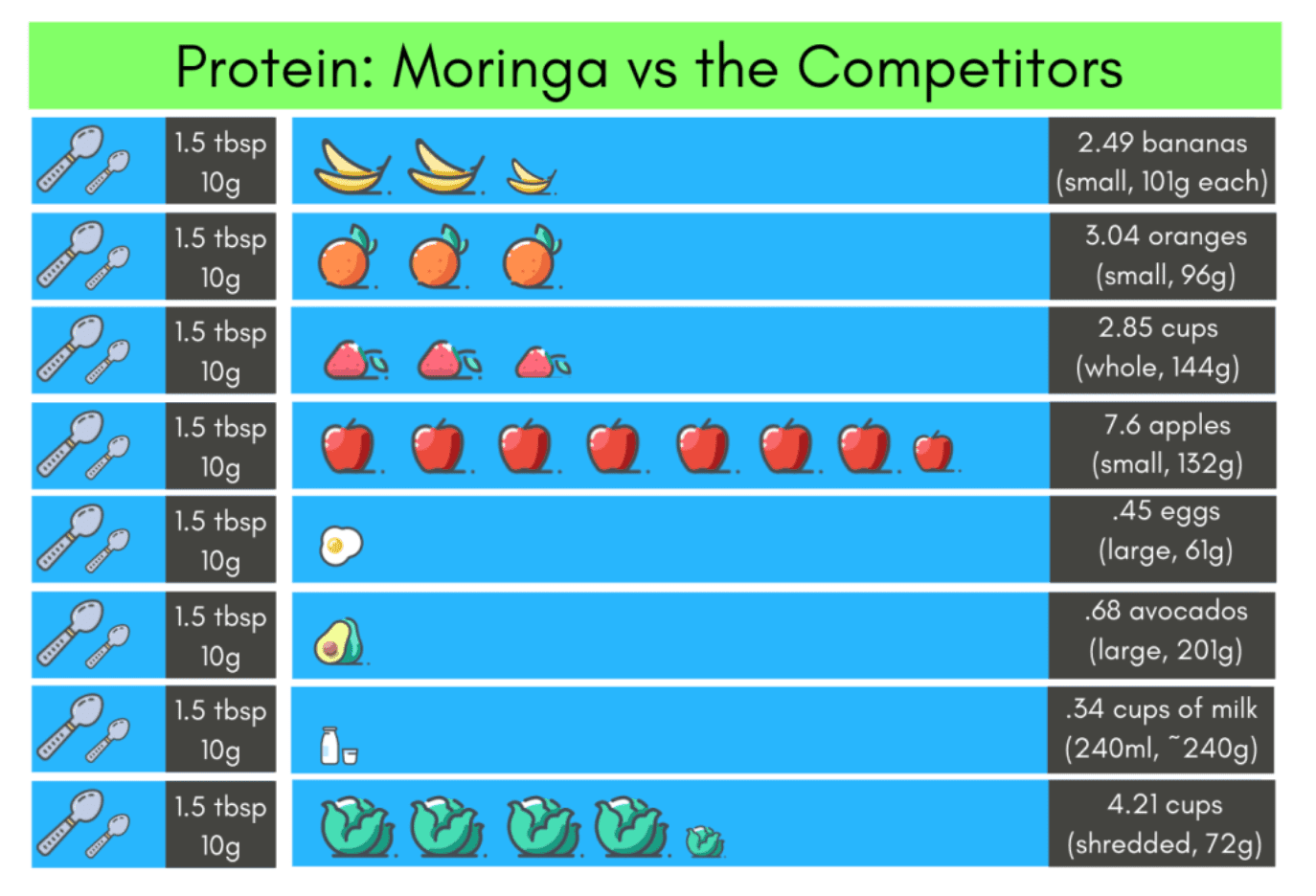
If you’re looking for protein, sure, steak and eggs are the classic choices.
But a big spoonful of Moringa sprinkled on your oatmeal serves almost 3 grams of protein, and it’s lighter on fat and cholesterol.
Remember, amino acids are the building blocks of protein, so Moringa leaves contain a ton of both!
Moringa Nutritional Value Chart: Fiber
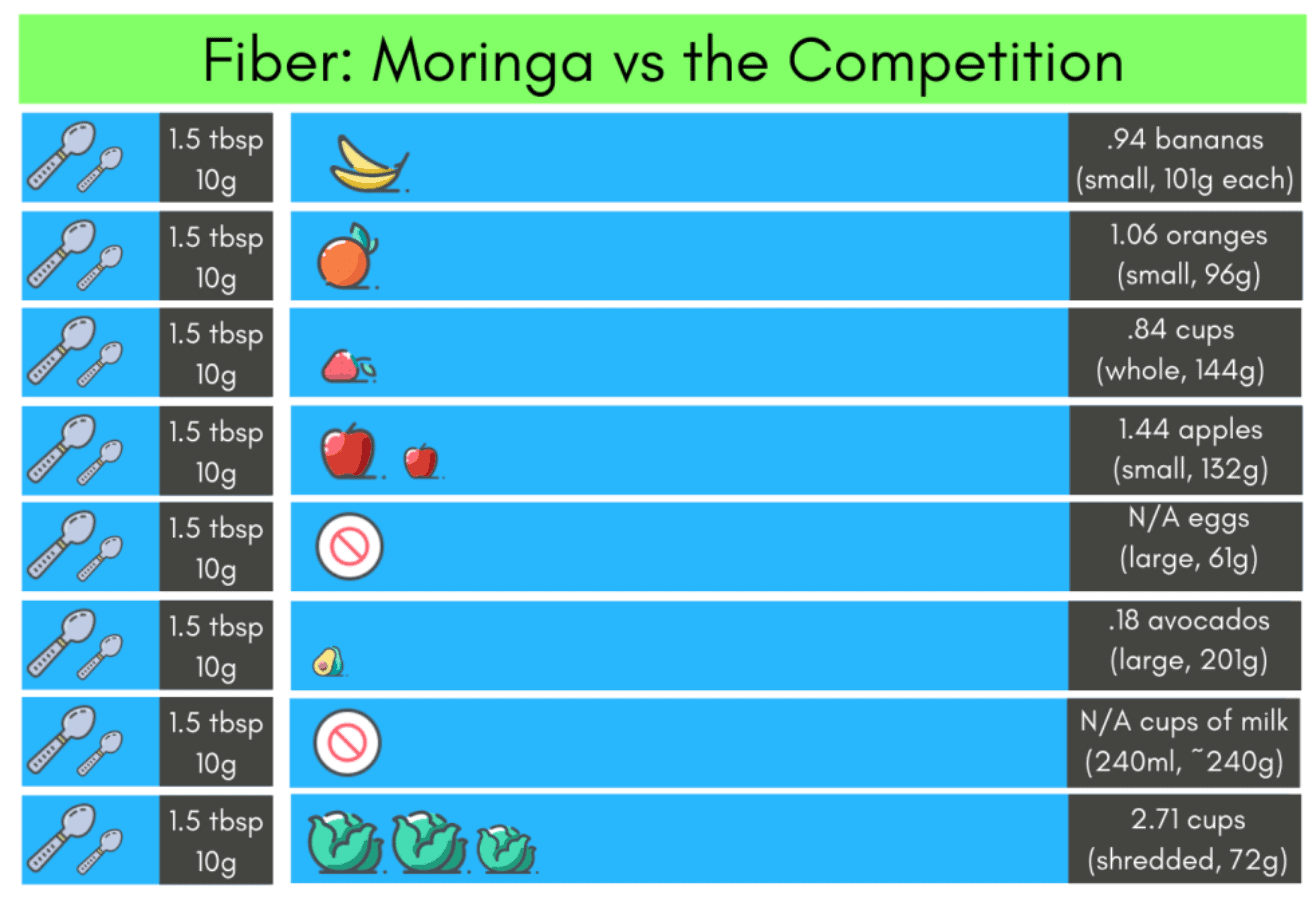
Fiber is where Moringa shines. In 10 grams, you get nearly 9% of your recommended daily fiber, similar to a small banana.
It’s not a fiber magic trick, but it’s a tasty way to step up your fiber game.
Moringa Nutritional Value Chart: Calcium
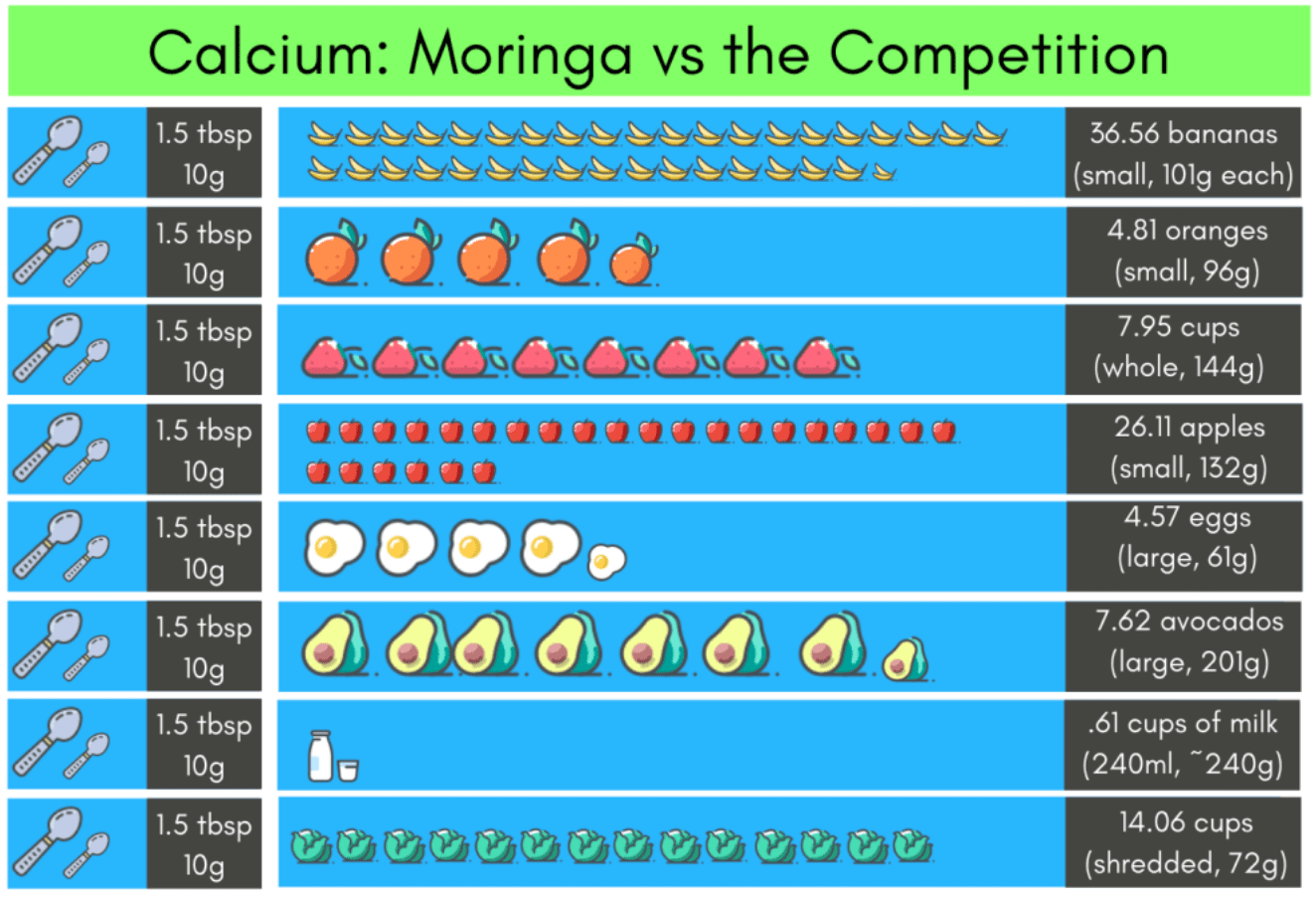
Now, Moringa goes wild with calcium. In 10 grams, you get over 14% of your daily calcium dose. That’s like the calcium in 36 bananas, 7+ avocados, or 4 and a half eggs. Not bad, huh?
Incorporating Moringa into your routine can be a cool and beneficial way to pump up your essential nutrients. Experiment with recipes, enjoy the unique flavor, and savor the nutritional perks of this superfood.
Cheers to good eats and good health!
Moringa Nutritional Value Chart: Magnesium
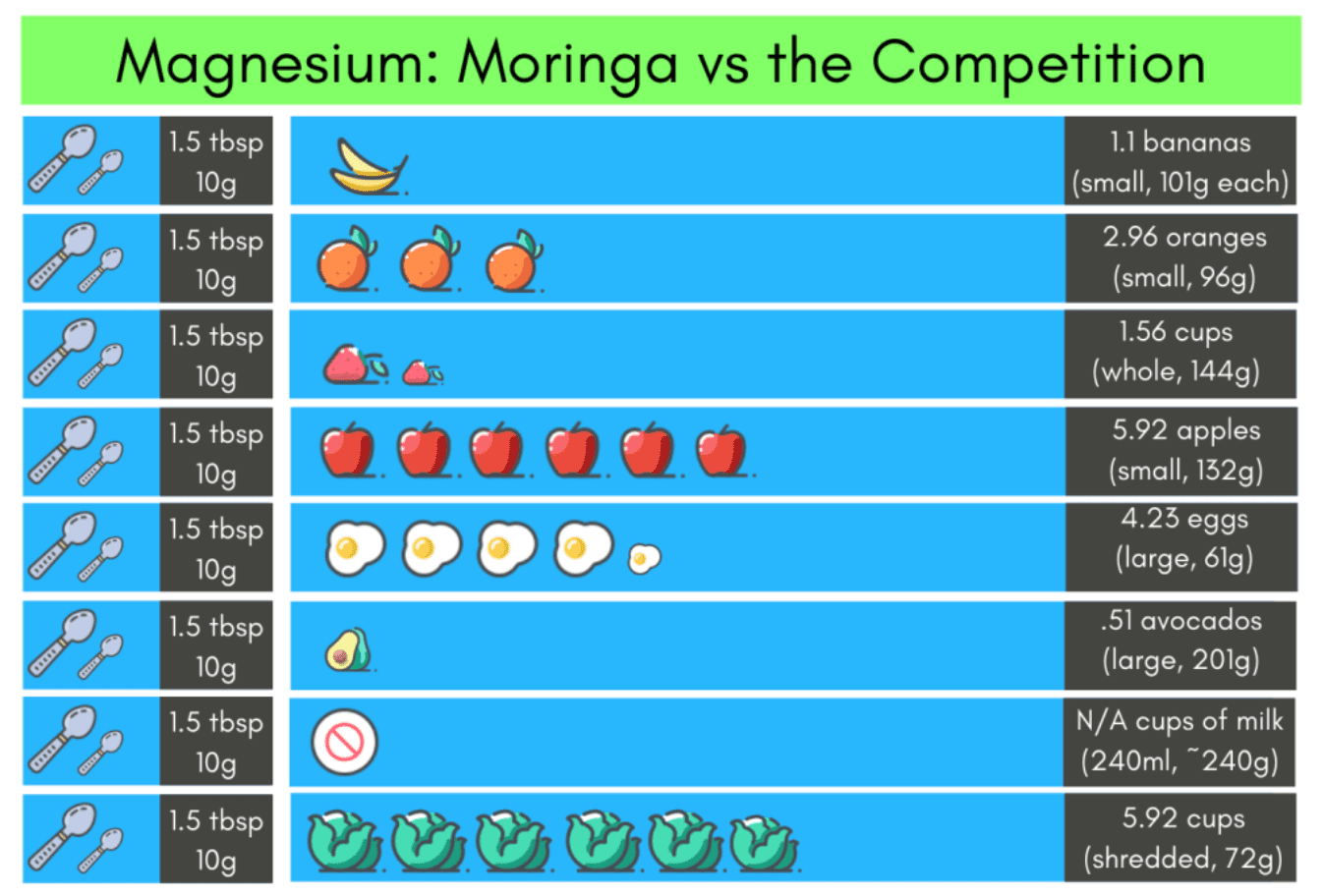
According to the American Osteopathic Association, about 50% of Americans are magnesium deficient. Given that magnesium is vital for healthy immune systems, nerve and muscle function, and maintaining appropriate blood glucose levels, that’s a big problem!
A heaping spoon of Moringa powder will give you 7% of your DV, though: the equivalent of what’s found in 3 oranges or 6 apples.
Moringa Nutritional Value Chart: Potassium
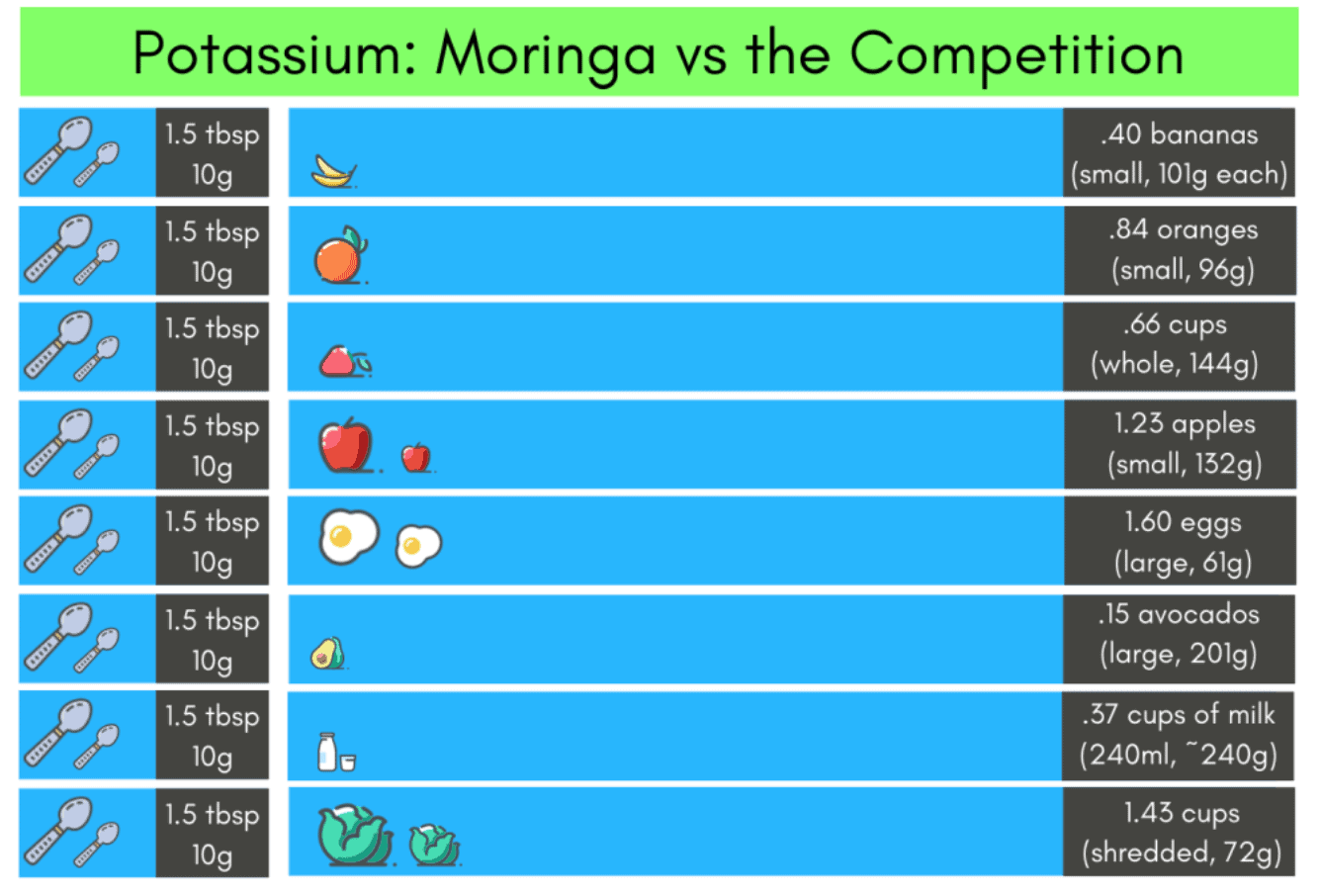
For the sake of transparency, it’s essential to acknowledge that Moringa alone may not be sufficient to address a deficiency.
Moringa provides a modest amount of potassium, constituting 3% of your recommended Daily Value. To put it into perspective, this is roughly equivalent to 2/3rds cup of strawberries or one and a half eggs.
Moringa also contains some Vitamin C, contributing about 2.4% of the Daily Value. So if your goal is to boost your daily intake of potassium or Vitamin C, it’s recommended to complement your Moringa consumption with a variety of other delicious fruits and vegetables!
Moringa Nutritional Value Chart: Iron
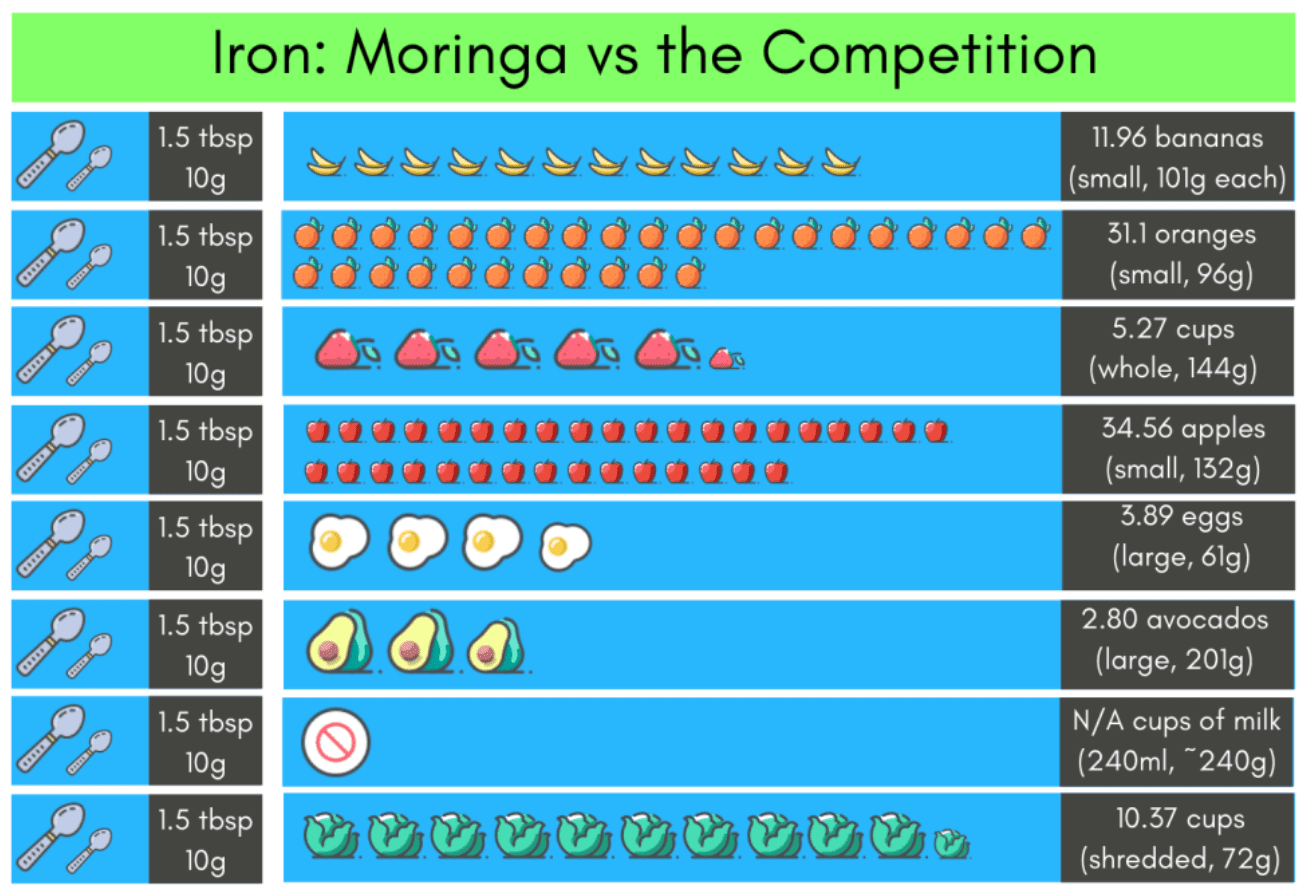
Iron is another aspect where Moringa stands out, with a 10-gram serving providing you with approximately 17% of your Daily Value (DV).
To put it in perspective, this is roughly equivalent to the iron content found in about 12 bananas, 31 oranges, 35 apples, or 4 eggs. This is pretty good news, considering that iron is crucial for the production of hemoglobin.
Moringa Nutritional Value Chart: Vitamin B

Thiamin, or Vitamin B-1, helps your body turn carbohydrates into energy.
A deficiency in thiamin often leads to symptoms like weakness, shortness of breath, and loss of appetite.
Good thing that Moringa has so much of it – a 10-gram serving provides you with approximately 14% of your recommended Daily Value (DV) of thiamin. To put it in perspective, this is equivalent to about 5 cups of whole strawberries and 7 eggs.
Moringa Nutritional Value Chart: Vitamin E
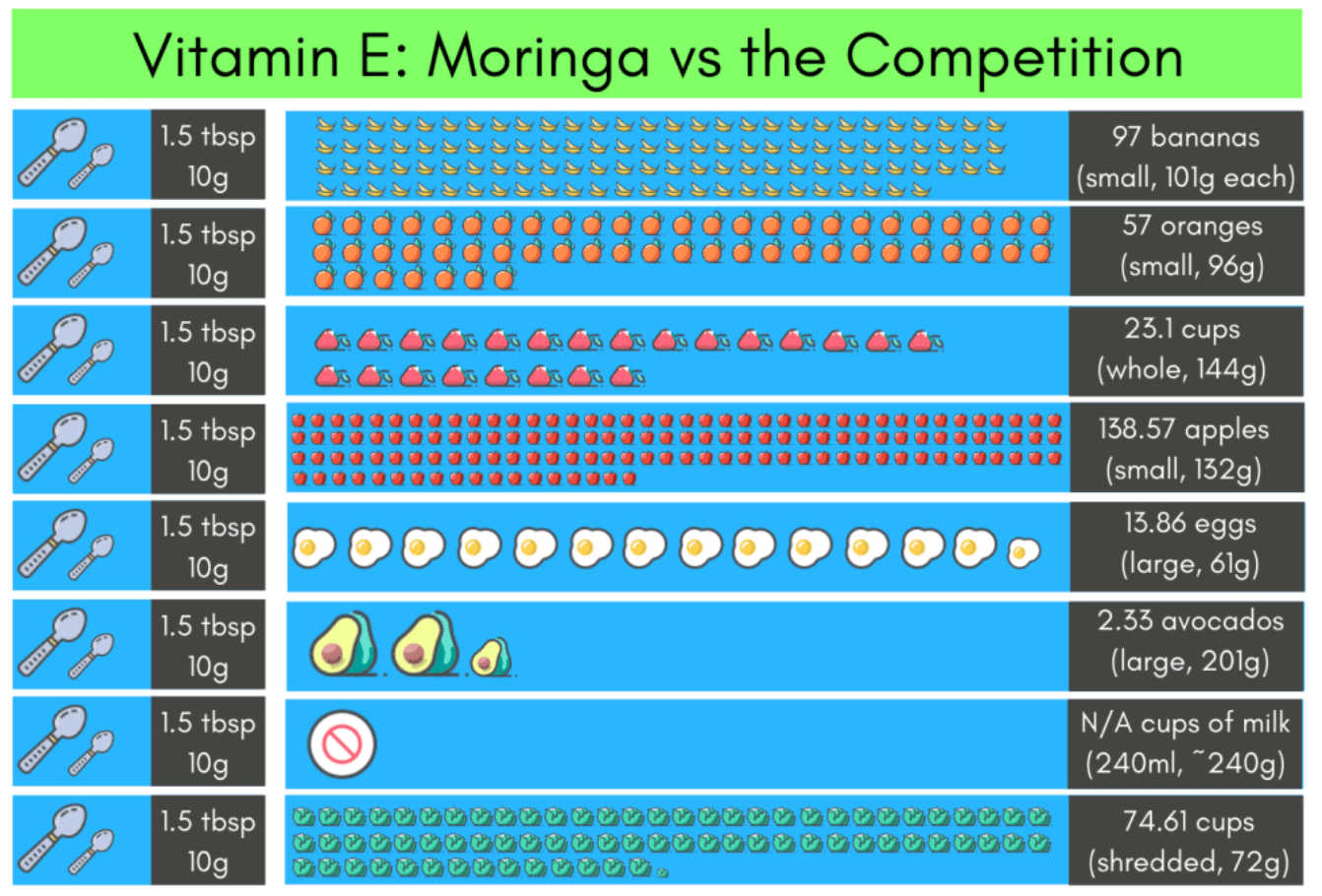
And finally, Vitamin E. As an antioxidant, Vitamin E not only shields cells from damage caused by free radicals but also aids in repairing those damaged cells.
And 10 grams of Moringa will give you almost 65% of your recommended daily value.
To put that into perspective, that’s the equivalent of eating 57 oranges, 97 bananas, or 138 apples.
Conclusion
In summary, Moringa is not a magic bullet; incorporating this drumstick tree into your daily routine won’t turn you into a superhero or miraculously cure all your diseases.
But it does represent a simple and accessible shift away from conventional medicine that may turn into impressive results. Give it a try – our family has, and we’ve never been disappointed!

For years now, Moringa has been a daily consumption in my life, incorporated in various forms such as capsules, food recipes, and soothing teas. Initially, my daughter and I embarked on this journey as an experiment, but as time went on, I delved deeper into its remarkable potential and unearthed the unlimited benefits it offers for our well-being and health. I got motivated by how much it positively impacted me and decided to share my insights about Moringa’s profound impact on health and overall living through my blog posts.
